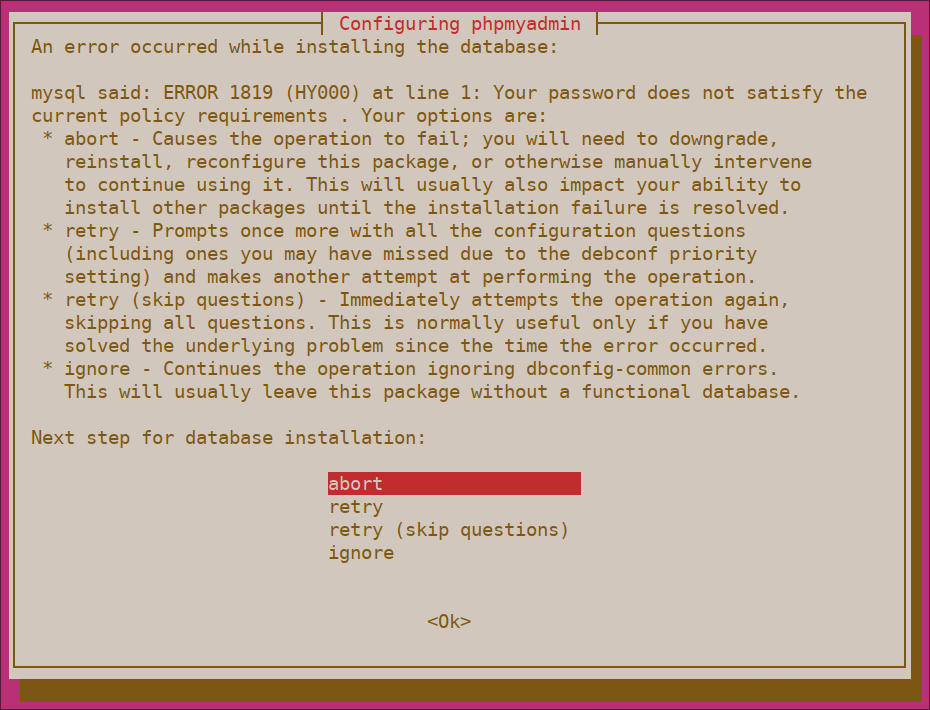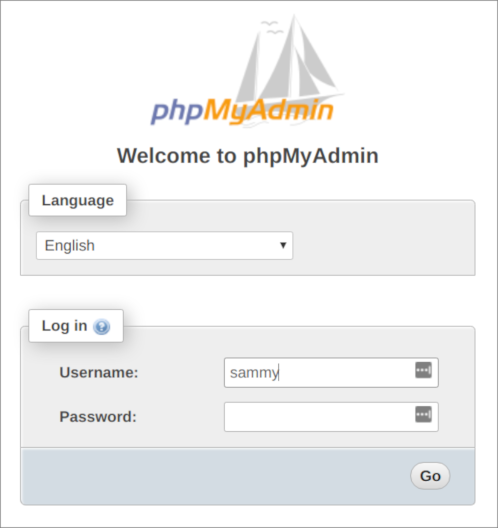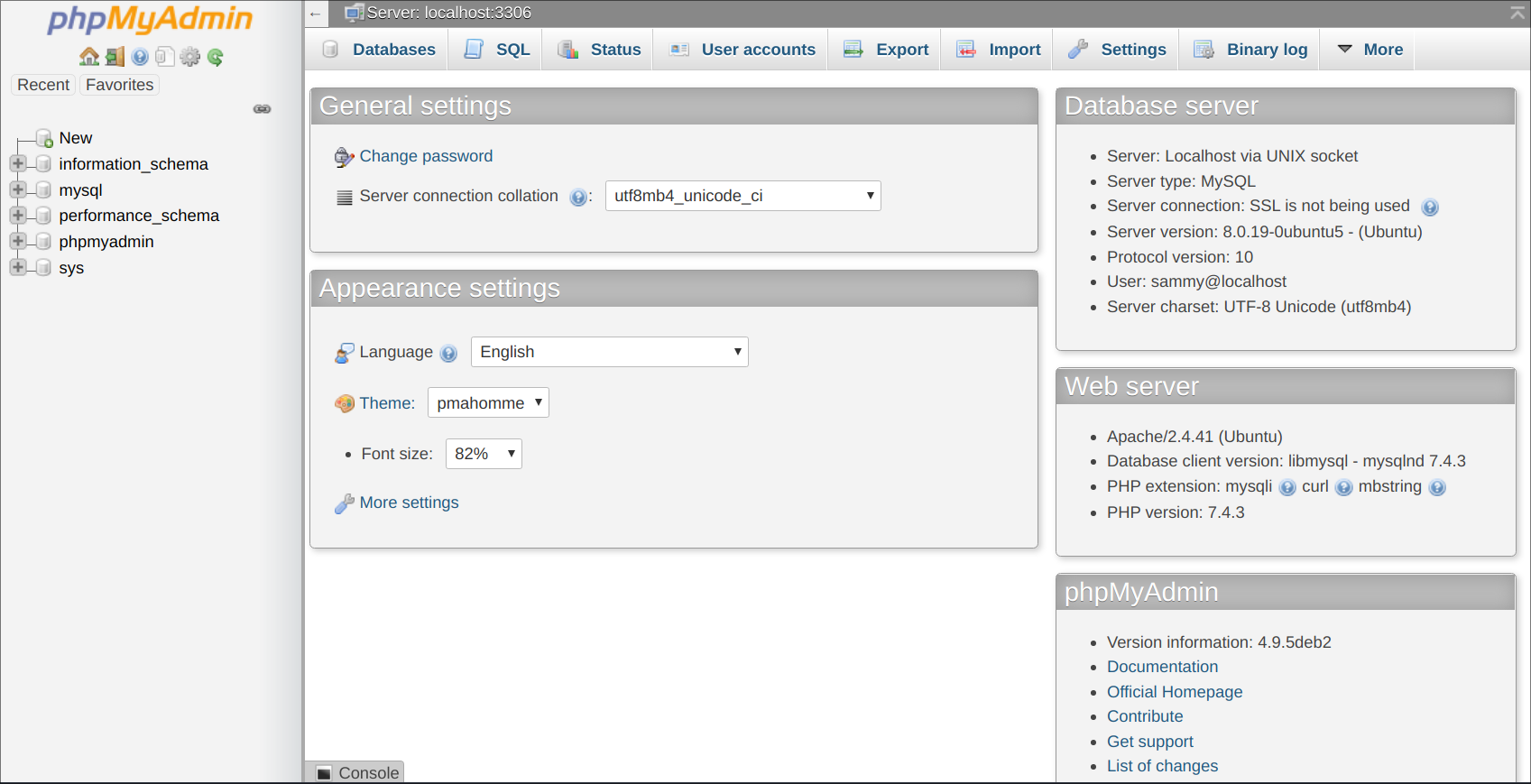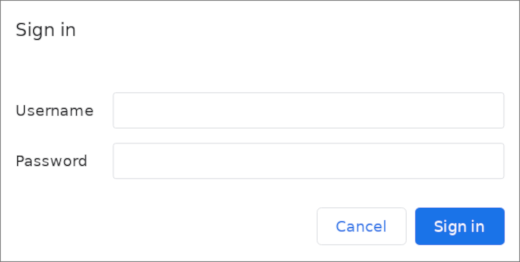Tutorial
How To Install and Secure phpMyAdmin on Ubuntu 20.04
Manager, Developer Education

Not using Ubuntu 20.04?Choose a different version or distribution.
An earlier version of this tutorial was written by Brennan Bearnes.
Introduction
While many users need the functionality of a database management system like MySQL, they may not feel comfortable interacting with the system solely from the MySQL prompt.
phpMyAdmin was created so that users can interact with MySQL through a web interface. In this guide, we’ll discuss how to install and secure phpMyAdmin so that you can safely use it to manage your databases on an Ubuntu 20.04 system.
1-Click deploy a database using DigitalOcean Managed Databases. Let DigitalOcean focus on scaling, maintenance, and upgrades for your database.
Prerequisites
In order to complete this guide, you will need:
- An Ubuntu 20.04 server. This server should have a non-root user with administrative privileges and a firewall configured with
ufw. To set this up, follow our initial server setup guide for Ubuntu 20.04. - A LAMP (Linux, Apache, MySQL, and PHP) stack installed on your Ubuntu 20.04 server. If this is not completed yet, you can follow this guide on installing a LAMP stack on Ubuntu 20.04.
Additionally, there are important security considerations when using software like phpMyAdmin, since it:
- Communicates directly with your MySQL installation
- Handles authentication using MySQL credentials
- Executes and returns results for arbitrary SQL queries
For these reasons, and because it is a widely-deployed PHP application which is frequently targeted for attack, you should never run phpMyAdmin on remote systems over a plain HTTP connection.
If you do not have an existing domain configured with an SSL/TLS certificate, you can follow this guide on securing Apache with Let’s Encrypt on Ubuntu 20.04. This will require you to register a domain name, create DNS records for your server, and set up an Apache Virtual Host.
Step 1 — Installing phpMyAdmin
You can use APT to install phpMyAdmin from the default Ubuntu repositories.
As your non-root sudo user, update your server’s package index:
Following that you can install the phpmyadmin package. Along with this package, the official documentation also recommends that you install a few PHP extensions onto your server to enable certain functionalities and improve performance.
If you followed the prerequisite LAMP stack tutorial, several of these modules will have been installed along with the php package. However, it’s recommended that you also install these packages:
php-mbstring: A module for managing non-ASCII strings and convert strings to different encodingsphp-zip: This extension supports uploading.zipfiles to phpMyAdminphp-gd: Enables support for the GD Graphics Libraryphp-json: Provides PHP with support for JSON serializationphp-curl: Allows PHP to interact with different kinds of servers using different protocols
Be aware that if you’re using a version of PHP other than the default one installed in the prerequisite LAMP stack tutorial, you will need to install the appropriate versions of these module packages. For instance, if you’re using PHP version 8.0, you will need to install the php8.0-mbstring package instead of the default php-mbstring package.
Run the following command to install these packages onto your system. Please note, though, that the installation process requires you to make some choices to configure phpMyAdmin correctly. We’ll walk through these options shortly:
Here are the options you should choose when prompted in order to configure your installation correctly:
- For the server selection, choose
apache2
Warning: When the prompt appears, “apache2” is highlighted, but not selected. If you do not hit SPACE to select Apache, the installer will not move the necessary files during installation. Hit SPACE, TAB, and then ENTER to select Apache.
- Select
Yeswhen asked whether to usedbconfig-commonto set up the database - You will then be asked to choose and confirm a MySQL application password for phpMyAdmin
Note: Assuming you installed MySQL by following Step 2 of the prerequisite LAMP stack tutorial, you may have decided to enable the Validate Password plugin. As of this writing, enabling this component will trigger an error when you attempt to set a password for the phpmyadmin user:

To resolve this, select the abort option to stop the installation process. Then, open up your MySQL prompt:
Or, if you enabled password authentication for the root MySQL user, run this command and then enter your password when prompted:
From the prompt, run the following command to disable the Validate Password component. Note that this won’t actually uninstall it, but just stop the component from being loaded on your MySQL server:
Following that, you can close the MySQL client:
Then try installing the phpmyadmin package again and it will work as expected:
Once phpMyAdmin is installed, you can open the MySQL prompt once again with sudo mysql or mysql -u root -p and then run the following command to re-enable the Validate Password component:
The installation process adds the phpMyAdmin Apache configuration file into the /etc/apache2/conf-enabled/ directory, where it is read automatically. To finish configuring Apache and PHP to work with phpMyAdmin, the only remaining task in this section of the tutorial is to is explicitly enable the mbstring PHP extension, which you can do by typing:
Afterwards, restart Apache for your changes to be recognized:
phpMyAdmin is now installed and configured to work with Apache. However, before you can log in and begin interacting with your MySQL databases, you will need to ensure that your MySQL users have the privileges required for interacting with the program.
Step 2 — Adjusting User Authentication and Privileges
When you installed phpMyAdmin onto your server, it automatically created a database user called phpmyadmin which performs certain underlying processes for the program. Rather than logging in as this user with the administrative password you set during installation, it’s recommended that you log in as either your root MySQL user or as a user dedicated to managing databases through the phpMyAdmin interface.
Configuring Password Access for the MySQL Root Account
In Ubuntu systems running MySQL 5.7 (and later versions), the root MySQL user is set to authenticate using the auth_socket plugin by default rather than with a password. This allows for some greater security and usability in many cases, but it can also complicate things when you need to allow an external program — like phpMyAdmin — to access the user.
In order to log in to phpMyAdmin as your root MySQL user, you will need to switch its authentication method from auth_socket to one that makes use of a password, if you haven’t already done so. To do this, open up the MySQL prompt from your terminal:
Next, check which authentication method each of your MySQL user accounts use with the following command:
Output+------------------+-------------------------------------------+-----------------------+-----------+
| user | authentication_string | plugin | host |
+------------------+-------------------------------------------+-----------------------+-----------+
| root | | auth_socket | localhost |
| mysql.session | *THISISNOTAVALIDPASSWORDTHATCANBEUSEDHERE | caching_sha2_password | localhost |
| mysql.sys | *THISISNOTAVALIDPASSWORDTHATCANBEUSEDHERE | caching_sha2_password | localhost |
| debian-sys-maint | *8486437DE5F65ADC4A4B001CA591363B64746D4C | caching_sha2_password | localhost |
| phpmyadmin | *5FD2B7524254B7F81B32873B1EA6D681503A5CA9 | caching_sha2_password | localhost |
+------------------+-------------------------------------------+-----------------------+-----------+
5 rows in set (0.00 sec)
In this example, you can see that the root user does in fact authenticate using the auth_socket plugin. To configure the root account to authenticate with a password, run the following ALTER USER command. Be sure to change password to a strong password of your choosing:
Note: The previous ALTER USER statement sets the root MySQL user to authenticate with the caching_sha2_password plugin. Per the official MySQL documentation, caching_sha2_password is MySQL’s preferred authentication plugin, as it provides more secure password encryption than the older, but still widely used, mysql_native_password.
However, some versions of PHP don’t work reliably with caching_sha2_password. PHP has reported that this issue was fixed as of PHP 7.4, but if you encounter an error when trying to log in to phpMyAdmin later on, you may want to set root to authenticate with mysql_native_password instead:
Then, check the authentication methods employed by each of your users again to confirm that root no longer authenticates using the auth_socket plugin:
Output+------------------+-------------------------------------------+-----------------------+-----------+
| user | authentication_string | plugin | host |
+------------------+-------------------------------------------+-----------------------+-----------+
| root | *DE06E242B88EFB1FE4B5083587C260BACB2A6158 | caching_sha2_password | localhost |
| mysql.session | *THISISNOTAVALIDPASSWORDTHATCANBEUSEDHERE | caching_sha2_password | localhost |
| mysql.sys | *THISISNOTAVALIDPASSWORDTHATCANBEUSEDHERE | caching_sha2_password | localhost |
| debian-sys-maint | *8486437DE5F65ADC4A4B001CA591363B64746D4C | caching_sha2_password | localhost |
| phpmyadmin | *5FD2B7524254B7F81B32873B1EA6D681503A5CA9 | caching_sha2_password | localhost |
+------------------+-------------------------------------------+-----------------------+-----------+
5 rows in set (0.00 sec)
You can see from this output that the root user will authenticate using a password. You can now log in to the phpMyAdmin interface as your root user with the password you’ve set for it here.
Configuring Password Access for a Dedicated MySQL User
Alternatively, some may find that it better suits their workflow to connect to phpMyAdmin with a dedicated user. To do this, open up the MySQL shell once again:
If you have password authentication enabled for your root user, as described in the previous section, you will need to run the following command and enter your password when prompted in order to connect:
From there, create a new user and give it a strong password:
Note: Again, depending on what version of PHP you have installed, you may want to set your new user to authenticate with mysql_native_password instead of caching_sha2_password:
Then, grant your new user appropriate privileges. For example, you could grant the user privileges to all tables within the database, as well as the power to add, change, and remove user privileges, with this command:
Following that, exit the MySQL shell:
You can now access the web interface by visiting your server’s domain name or public IP address followed by /phpmyadmin:
https://your_domain_or_IP/phpmyadmin

Log in to the interface, either as root or with the new username and password you just configured.
When you log in, you’ll see the user interface, which will look something like this:

Now that you’re able to connect and interact with phpMyAdmin, all that’s left to do is harden your system’s security to protect it from attackers.
Step 3 — Securing Your phpMyAdmin Instance
Because of its ubiquity, phpMyAdmin is a popular target for attackers, and you should take extra care to prevent unauthorized access. One way of doing this is to place a gateway in front of the entire application by using Apache’s built-in .htaccess authentication and authorization functionalities.
To do this, you must first enable the use of .htaccess file overrides by editing your phpMyAdmin installation’s Apache configuration file.
Use your preferred text editor to edit the phpmyadmin.conf file that has been placed in your Apache configuration directory. Here, we’ll use nano:
Add an AllowOverride All directive within the <Directory /usr/share/phpmyadmin> section of the configuration file, like this:
<Directory /usr/share/phpmyadmin>
Options SymLinksIfOwnerMatch
DirectoryIndex index.php
AllowOverride All
. . .
When you have added this line, save and close the file. If you used nano to edit the file, do so by pressing CTRL + X, Y, and then ENTER.
To implement the changes you made, restart Apache:
Now that you have enabled the use of .htaccess files for your application, you need to create one to actually implement some security.
In order for this to be successful, the file must be created within the application directory. You can create the necessary file and open it in your text editor with root privileges by typing:
Within this file, enter the following information:
AuthType Basic
AuthName "Restricted Files"
AuthUserFile /etc/phpmyadmin/.htpasswd
Require valid-user
Here is what each of these lines mean:
AuthType Basic: This line specifies the authentication type that you are implementing. This type will implement password authentication using a password file.AuthName: This sets the message for the authentication dialog box. You should keep this generic so that unauthorized users won’t gain any information about what is being protected.AuthUserFile: This sets the location of the password file that will be used for authentication. This should be outside of the directories that are being served. We will create this file shortly.Require valid-user: This specifies that only authenticated users should be given access to this resource. This is what actually stops unauthorized users from entering.
When you are finished, save and close the file.
The location that you selected for your password file was /etc/phpmyadmin/.htpasswd. You can now create this file and pass it an initial user with the htpasswd utility:
You will be prompted to select and confirm a password for the user you are creating. Afterwards, the file is created with the hashed password that you entered.
If you want to enter an additional user, you need to do so without the -c flag, like this:
Then restart Apache to put .htaccess authentication into effect:
Now, when you access your phpMyAdmin subdirectory, you will be prompted for the additional account name and password that you just configured:
https://domain_name_or_IP/phpmyadmin

After entering the Apache authentication, you’ll be taken to the regular phpMyAdmin authentication page to enter your MySQL credentials. By adding an extra set of non-MySQL credentials, you’re providing your database with an additional layer of security. This is desirable, since phpMyAdmin has been vulnerable to security threats in the past.
Conclusion
You should now have phpMyAdmin configured and ready to use on your Ubuntu 20.04 server. Using this interface, you can create databases, users, and tables, as well as perform the usual operations like deleting and modifying structures and data.
Get Ubuntu on a hosted virtual machine in seconds with DigitalOcean Droplets! Simple enough for any user, powerful enough for fast-growing applications or businesses.
This textbox defaults to using Markdown to format your answer.
You can type !ref in this text area to quickly search our full set of tutorials, documentation & marketplace offerings and insert the link!
Hello Mark,
thanks for the tutorial, could follow well. Just had a problem to access phpmyadmin via localhost. I got a 404 error.
What helped was:
Source: https://help.ubuntu.com/community/ApacheMySQLPHP#Troubleshooting_Phpmyadmin_.26_mysql-workbench
In case anybody else has the same problem. Cheers, Thomas
Hi Mark , Thomas This solved my problem, however I did the install twice (rolled back the first one) and I’m pretty sure that I didn’t get a prompt for apache2,
if you are working on https://localhost/phpmyadmin. The following line (line 363) in the config.default.php file $cfg[‘Servers’][$i][‘AllowNoPassword’] = false; make it this $cfg[‘Servers’][$i][‘AllowNoPassword’] = true;
and as our admin brother told us above, type root (in the user section) and leave the password blank. Just type root at the login. But don’t use this method for your regular website :)
If you’re a noob like me, make sure you do NOT include the $ in front of Mark’s statement “$ Include /etc/phpmyadmin/apache.conf” - enter it without the $. Otherwise you’ll get errors.
Hi Mark!
I followed the tutorial but the address to access phpmyadmin does not work. I have an error “The request URL was not found on this server”. And apparently the file sudo nano /etc/apache2/conf-available/phpmyadmin.conf does not exist because when i tried to open it was empty. I need help for today. Please
it is resolved ! If it can help someone.
I think it’s because I didn’t follow this step to the letter: Warning: When the prompt appears, “apache2” is highlighted, but not selected. If you do not hit SPACE to select Apache, the installer will not move the necessary files during installation. Hit SPACE, TAB, and then ENTER to select Apache.
Solution: sudo ln -s /etc/phpmyadmin/apache.conf /etc/apache2/conf-available/phpmyadmin.conf sudo a2enconf phpmyadmin sudo /etc/init.d/apache2 reload
Thanks! This solve my problem.
Thanks, this solved my issue 👍
Thanks you very much !
Thanks a lot.
This doesnt help for the Worpress Droplet. I keep getting errors about user debian-sys-maint not having enough rights to configure phpmyadmin package while installing.
Package phpmyadmin is not available, but is referred to by another package. This may mean that the package is missing, has been obsoleted, or is only available from another source
E: Package ‘phpmyadmin’ has no installation candidate
Hi all. Mark, thank you for the great tutorial. I did something unintended, namely, I copied this phrase into my terminal and now I have a user username.
It is no big problem, but I want to keep my administration nice and tidy. How can I remove this user username? I have created a user with the name that I want to use, so that I can enter phpmyadmin.
Hello @katovonkatz,
Thank you for your question! You can delete user credentials from the
.htpasswdfile by running thehtpasswdcommand with the-Doption. The following command will delete the user username from the/etc/phpmyadmin/.htpasswdfile:Thank you!
Hello Mark,
I’m trying to run a create table SQL and it’s giving me the following error:
Here is my SQL:
Here’s a screencast: https://gyazo.com/4ec6302e8f595327455908cb91c34a83
It seems to be working fine for some other types (e.g. mediumint / date). For example the following sql works:
Followed the above instructions a few times and it’s giving me the same error. Any insight on what the issue is?
Thanks in advance, Will
Step 2 — Adjusting User Authentication and Privileges -> I completed this step on a brand new D.O. Ubuntu 20.4 install that followed the D.O. LAMP guide and I’ve lost all access to MySQL. Per the LAMP setup guide I configured a complex password for MySQL in case authentication needed to be switched from UNIX_Socket to Password (seems they recommend against it) and… I cannot log into MySQL nor change the password. Surely I had a misstep but can’t figure out where!
Mark, would you be able to do a similar guide for a LEMP stack? Cheers
Hello @transat,
Apologies for my delay in following up. I just published a tutorial on How To Install and Secure phpMyAdmin with Nginx on an Ubuntu 20.04 server. I hope you find it useful!
:D What I like DigitalOcean is guide article is best with detail on how to get me walkthrough any technical problem.
Clear and know what the step will be error and get fix. Keep it up.
thank you. I did it. <3
I would like to see set up where PhpMyAdmin shows only one database related to the user which is logged in, with the privileges only for this database/databases.
This comment has been deleted
I followed the instructions here but when I enter "https://mydomain.com/phpmyadmin my browser redirects to an unsecure connection: “http://123.45.67.8/phpmyadmin”.
I’m using “Let’s Encrypt” on my domain, which works fine. But I’ve read that it doesn’t work for IP addresses.
Any solutions?
Fixed it. Apparently I hadn’t set up the virtual host correctly.
It’s working as expected now, with SSL access to phpmyadmin as described.
Thank you for your confirmation, I want to point out that it is true that you can’t add SSL certificates to your IP address so going to your domain was the proper option!
ERROR 1045 (28000): Access denied for user ‘debian-sys-maint’@‘localhost’ (using password: YES) .
Is there any solution? error in step 1 after confirmation Mysql password for phpmyadmin
if skipping dbconfig-common, then no errors…
Another excellent walk-through!
The idiosyncrasies that show up in new iterations of apache and php and mysql can catch you by surprise if you haven’t built out a server in a few years.
Thank you so much for this well arranged and logical article.
I have a working phpmyadmin after I granted the user phpmyadmin access right is MySQL. I got this message: Create a database named ‘phpmyadmin’ and setup the phpMyAdmin configuration storage there. Where do I find an SQL script that fills phpmyadmin ?
On step two, when trying to log into mysql, I get this …
$ sudo mysql ERROR 1045 (28000): Access denied for user ‘root’@‘localhost’ (using password: NO)
Any suggestions? Thanks.
You can use
sudo mysql -u root -pto get around this. It will log you in as userrootand then prompt you for the passwordwhen I try to start the installation of phpmyadmin it tells me that the user debian-sys-maint does not have permission. Abort and create the user in the database, but it won’t let me give it admin privileges. I install the droplet with wordpress already installed
At this step: mysql>UNINSTALL COMPONENT “file://component_validate_password”;
I get the following error. ERROR 3537 (HY000): Component specified by URN ‘file://component_validate_password’ to unload has not been loaded before.
That is alright, this means that that you don’t have that compontent installed probably because you haven’t run
mysql_secure_installationwhen installing the service.Great Blog, it worked. Thank you
You can go a step further to avoid script attacks by changing the route to phpmyadmin in /etc/apache2/conf-available/phpmyadmin.conf Just change at the beginning of the file “Alias /phpmyadmin /usr/share/phpmyadmin” by “Alias /yourcustomroute /usr/share/phpmyadmin” Makes it even harder to find and really does not tell attackers what is behind the access point if you use a good name.
Hello !
I followed the tutorial but answered too fast to the “For the server selection, choose apache2” point without reading the WARNING section (even if it was written in red, my fault) How can I start from scratch the procedure ? I tried apt remove with no success…
Thanks !
Lovely article. Clear instructions, thks.
I have followed the tutorial step by step on a wordpress droplet, and I get a 404 page when I load https://URL/phpmyadmin
What did I miss? Thanks
In such cases try using your Droplet’s Ip address see if that helps. It’s possible you missed something in the tutorial so you should go back and review it again.
Install phpMyAdmin using the command:
sudo apt update sudo apt install phpmyadminDuring the installation, select “apache2” when prompted to choose a web server.
Configure Apache to recognize phpMyAdmin@localhost by creating a symbolic link:
sudo ln -s /usr/share/phpmyadmin /var/www/html/phpmyadminSecure phpMyAdmin by creating a new user with strong credentials and granting it appropriate privileges:
sudo mysql CREATE USER 'newuser'@'localhost' IDENTIFIED BY 'password'; GRANT SELECT, INSERT, UPDATE, DELETE ON database_name.* TO 'newuser'@'localhost'; FLUSH PRIVILEGES;Edit the phpMyAdmin configuration file to enable HTTPS and restrict access to certain IP addresses or hosts:
sudo nano /etc/phpmyadmin/config.inc.phpAdd the following lines at the end of the file:
$cfg['ForceSSL'] = true; $cfg['Servers'][1]['host'] = 'localhost'; $cfg['Servers'][1]['auth_type'] = 'cookie'; $cfg['Servers'][1]['AllowNoPassword'] = false; $cfg['Servers'][1]['AllowRoot'] = false; $cfg['Servers'][1]['AllowDeny']['order'] = 'deny,allow'; $cfg['Servers'][1]['AllowDeny']['rules'] = array( 'deny from all', 'allow from 192.168.0.1', 'allow from localhost' );Replace “192.168.0.1” with the IP address or hostname of the machines that are allowed to access phpMyAdmin.
Restart Apache for the changes to take effect:
sudo systemctl restart apache2Now you should be able to access phpMyAdmin by going to
https://your-server-name-or-ip/phpmyadminin your web browser, and login using the new user credentials you created.and
To install phpMyAdmin using the command line, you can use the following steps:
1.Update Package Lists
2.Install phpMyAdmin:
During the installation, you will be prompted to choose the web server that should be automatically configured to run phpMyAdmin. Select the appropriate server (usually Apache 2) by pressing the Space bar, then hit Enter to continue.
Once completed, you should be able to access phpMyAdmin by navigating to http://[url=https://1001pisowifi.com/]your_server_ip[/url]/phpmyadmin in your web browser.
Ensure that your server has PHP and a web server (like Apache or Nginx) installed before running these commands. If not, you’ll need to install them first.
I have followed all the steps but when I enter domain/phpmyadmin it downloads a php code file instead of showing me the phpmyadmin home screen.
This comment has been deleted
Hi there. Might be useful idea as it was for me: during installation phpmyadmin on Ubuntu 22.04, on step
sudo phpenmod mbstringI’ve got:Solved with:
sudo apt install -y php8.4-mbstringThis comment has been deleted